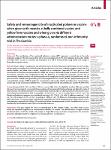Safety and immunogenicity of inactivated poliovirus vaccine when given with measles–rubella combined vaccine and yellow fever vaccine and when given via different administration routes: a phase 4, randomised, non-inferiority trial in The Gambia
Clarke, Ed
Saidu, Yauba
Adetifa, Jane U.
Adigweme, Ikechukwu
Hydara, Mariama Badjie
Moneke-Anyanwoke, Ngozi
Umesi, Ama
Roberts, Elishia
Cham, Pa Modou
Okoye, Michael E.
Brown, Kevin E.
Niedrig, Matthias
Chowdhury, Panchali Roy
Clemens, Ralf
Bandyopadhyay, Ananda S.
Mueller, Jenny
Jeffries, David J.
Kampmann, Beate
Background: The introduction of the inactivated poliovirus vaccine (IPV) represents a crucial step in the polio eradication endgame. This trial examined the safety and immunogenicity of IPV given alongside the measles–rubella and yellow fever vaccines at 9 months and when given as a full or fractional dose using needle and syringe or disposable-syringe jet injector. Methods: We did a phase 4, randomised, non-inferiority trial at three periurban government clinics in west Gambia. Infants aged 9–10 months who had already received oral poliovirus vaccine were randomly assigned to receive the IPV, measles–rubella, and yellow fever vaccines, singularly or in combination. Separately, IPV was given as a full intramuscular or fractional intradermal dose by needle and syringe or disposable-syringe jet injector at a second visit. The primary outcomes were seroprevalence rates for poliovirus 4–6 weeks post-vaccination and the rate of seroconversion between baseline and post-vaccination serum samples for measles, rubella, and yellow fever; and the post-vaccination antibody titres generated against each component of the vaccines. We did a per-protocol analysis with a non-inferiority margin of 10% for poliovirus seroprevalence and measles, rubella, and yellow fever seroconversion, and (1/3) log2 for log2-transformed antibody titres. This trial is registered with ClinicalTrials.gov, number NCT01847872. Findings: Between July 10, 2013, and May 8, 2014, we assessed 1662 infants for eligibility, of whom 1504 were enrolled into one of seven groups for vaccine interference and one of four groups for fractional dosing and alternative route of administration. The rubella and yellow fever antibody titres were reduced by co-administration but the seroconversion rates achieved non-inferiority in both cases (rubella, −4·5% [95% CI −9·5 to −0·1]; yellow fever, 1·2% [–2·9 to 5·5]). Measles and poliovirus responses were unaffected (measles, 6·8% [95% CI −1·4 to 14·9]; poliovirus serotype 1, 1·6% [–6·7 to 4·7]; serotype 2, 0·0% [–2·1 to 2·1]; serotype 3, 0·0% [–3·8 to 3·9]). Poliovirus seroprevalence was universally high (>97%) after vaccination, but the antibody titres generated by fractional intradermal doses of IPV did not achieve non-inferiority compared with full dose. The number of infants who seroconverted or had a four-fold rise in titres was also lower by the intradermal route. There were no safety concerns. Interpretation: The data support the future co-administration of IPV, measles–rubella, and yellow fever vaccines within the Expanded Programme on Immunization schedule at 9 months. The administration of single fractional intradermal doses of IPV by needle and syringe or disposable-syringe jet injector compromises the immunity generated, although it results in a high post-vaccination poliovirus seroprevalence.
Dateien zu dieser Publikation
Keine Lizenzangabe

